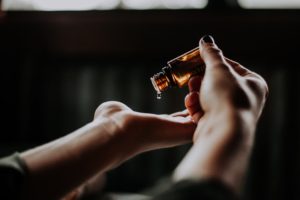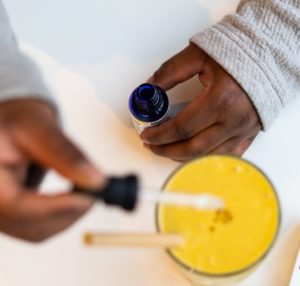
Blog
CBD Explained: What it is and Why it’s Everywhere
Cannabidiol (CBD) has seemingly burst overnight into public consciousness, popping up in products on store shelves from coast to coast, regularly generating news headlines. This ingredient brings with it a host of wide-ranging claims and the mystique of countercultural, alternative medicine.
CBD is widely available in the American consumer marketplace, but what exactly is it, what does it promise and why has it become nearly ubiquitous?
Is CBD the same as marijuana?
No. CBD is a compound that can be derived from either the hemp or marijuana plant. While CBD is one of hundreds of compounds present in marijuana, it is not psychoactive, i.e., it does not produce a “high.” Tetrahydrocannabinol (THC) is the compound that creates the high sensation.
What are the health benefits of CBD?
Wide-ranging claims have been made regarding CBD’s benefits – from pain relief to sleep aid to cancer cure. A 2017 report from the World Health Organization found “no evidence of public health related problems associated with the use of pure CBD,” but little comprehensive research exists on the compound.
A handful of studies suggest CBD may help people fall asleep and stay asleep, and an animal study showed topical CBD cream may help reduce pain and inflammation related to arthritis. Such studies are intriguing, but there is clearly a need for a more comprehensive study of CBD in humans to validate or disprove CBD health claims.
The one exception is the considerable scientific evidence supporting CBD’s effectiveness as an antiseizure agent in treating rare types of childhood epilepsy. The U.S. Food and Drug Administration (FDA) recently approved a new drug called Epidiolex, comprised of the active ingredient CBD, derived from marijuana.
What are people using CBD for and where are they buying it?
Consumers are most commonly purchasing CBD in oils or other skincare products and in foods, including dietary supplements.
They are using it primarily for pain management, stress reduction or as a sleep aid. But many Americans may be making medical decisions on CBD’s unproven claims — something the FDA has warned against. The FDA cautioned consumers not to use CBD in place of “getting important medical care, such as proper diagnosis, treatment and supportive care.” Findings from the Consumer Brands Association corroborate this concern, with respondents reporting that they use CBD to alleviate cancer symptoms, treat effects of a neurological disorder and improve heart or bone health.
Where Americans are purchasing CBD products varies widely. Most consumers are buying CBD at specialty shops or online. About three-in-ten have purchased CBD products from grocery stores, pharmacies or gas stations. Some are even finding CBD products at farmers markets.
Why is CBD booming now?
Just a few years ago, awareness of CBD was limited to a small number of researchers and entrepreneurs working in the nascent medical marijuana industry. Today, CBD products are widely available for sale at natural food stores, pharmacies, gyms and convenience stores across the country. What accounts for this?
Most observers point to Congress’s 2018 Farm Bill. Prior to 2018, federal law classified hemp as a controlled substance alongside street drugs such as heroin and cocaine, despite hemp’s lack of psychoactive properties and traditional use as a source of fiber for products such as rope. The 2018 Farm Bill removed this classification and legalized commercial cultivation of hemp and the marketing of hemp-derived products such as CBD, provided the hemp plant and resulting CBD products have less than 0.3 percent THC.
Importantly, the 2018 Farm Bill delegated to states and native American tribes the authority to regulate the production and sale of hemp and hemp-derived products. This delegation of federal authority has helped fuel both the explosive growth of the CBD market and the haphazard, patchwork legal and regulatory environment that now surrounds CBD products.
How big is the CBD market?
Given the hype surrounding CBD and the many claims made on its behalf, it’s no wonder consumer demand is growing at breakneck speed. Analysts project the market for CBD products could top $15-20 billion by 2025, and a recent poll by the Consumer Brands Association found nearly two-thirds of American consumers are aware of CBD, and 34 percent of Americans have purchased a CBD product.
Despite strong consumer demand, the murky legal and regulatory atmosphere surrounding CBD stands as a key barrier to market growth – varying considerably from state to state.
Well-known consumer brands, for example, are wary of entering a new market without clear, consistent “rules of the road” that can guide capital investments, oversee interstate supply chains and govern marketing claims. Big consumer brands may or may not choose to enter the CBD marketplace – but without a clear, research-based regulatory framework under the auspices of a federal authority such as FDA, it is highly unlikely we will see such brands participate in the current market.
How knowledgeable are consumers about CBD?
While consumer interest is strong and the CBD market is booming, public understanding of CBD shows tremendous confusion and misperceptions.
Fully 92 percent of consumers who are aware of CBD either incorrectly assume or have no idea if federal consumer protections are in place. More than half (53%) assume CBD is regulated by the FDA. It is not.
In spite of this, the Consumer Brands Association survey found that two-thirds (66%) of respondents believe CBD products are safe. Only 15 percent admitted to having unanswered questions about the safety of CBD products.
Likewise, half of consumers (51%) incorrectly believe CBD has the potential to intoxicate those who consume it. Nearly a quarter (24%) of respondents who purchased CBD products report doing so because they thought it would give them a “high.”
Why is federal action needed now?
Developing a safe, consistent CBD marketplace presents a real challenge. CBD’s popularity, combined with the lack of rigorous scientific research and an inconsistent patchwork of state-by-state regulations, is fueling an environment where poorly informed consumers are largely on their own.
Why haven’t they taken action already?
There is a clear need for federal regulation of CBD products; however, presently, there is not a clear path. As it stands today, CBD is an active ingredient in an approved drug (Epidiolex), making it illegal to use as an ingredient in foods, including dietary supplements and beverages.
The comprehensive research that is badly needed on the safety of CBD as an ingredient in foods, including dietary supplements and beverages, is made more difficult by the regulatory hurdles to studying it. There are substantial layers of bureaucracy — getting approvals from a range of federal, state or local agencies, institutions and organizations — that result from cannabis being treated like a narcotic. CBD will have to be decoupled from that view to open up pathways to meaningful and necessary research.
It is the role of federal agencies to ensure a safe, transparent consumer market. Instead, it’s the Wild West. The federal government must move quickly to fund much-needed CBD research and federal agencies should provide regulatory clarity by establishing a uniform, federal framework that protects consumers.
Published on October 29, 2019



